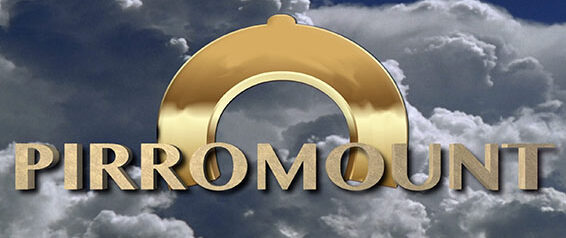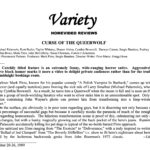DIGITAL NEWS
Interview With Mark Pirro
by Debra Kaufman
Mark Pirro is head of Pirromount Pictures, founded in 1981 in Van Nuys, CA and an expert in the art and craft of ultra-low budget filmmaking. His latest film, “Color-Blinded,” was made for under $500.
Q: How did you get your start in filmmaking?
A: When I was 13 I got a Super 8mm camera for Christmas, and I became a little camera nerd. I got my friends to be actors and made little 10-minute films on every subject I could imagine, including a monster/vampire movie and “Batman Junior.” When I was 18, I got a job as a tour guide at Universal Studios. I was eventually fired for adlibbing too much. When I was an usher at the Egyptian Theatre, I decided to go back to what I always wanted to do: make movies. I bought a Super 8mm camera, this time equipped for sound, at Lloyd’s Camera inHollywood, and called my old friends from Universal and, for a couple of hundred dollars, I produced “Buns,” a 22-minute short about a guy who goes into a murderous frenzy every time he sees a hamburger. Next, I produced the 45-minute James Bond spoof, “The Spy Who Did It Better” for about $1,200. It got some festival awards and the appreciative attention of James Bond fans.
Q: Were you making a living off of these films?
A: Oh no, I was still doing odd jobs, including being a chauffeur for Jim Backus. “A Polish Vampire in Burbank” was the first film to sell. I began shooting that in 1981 and, in 1984,sold it to Simitar Entertainment, for a 7-year deal for about $50,000. It cost $2,500 to produce. This was my first feature length film, and since home video was new at the time, there were no made-for-home-video movies.This was the turning point. I immediately started “Curse of the Queerwolf,” about a guy who turns queer when the moon rises. That was shot for $10,000- and about $4,000 went to buy equipment for synchronized sound. Since then, I’ve also made “Death Row Game Show,” “Nudist Colony of the Dead,” “Buford’s Beach Bunnies,” and “Color-Blinded.” I also wrote “My Mom’s a Werewolf” which was produced for another company.
Q: What constitutes a low-budget film? And how do you raise the money for your pictures?
A: In Hollywood, low budget is anything under $5 million! I coined the phrase “ultra-low budget” because I’ve produced movies for such low budgets it’s ridiculous But whenever anyone asks the budget, I always say under $1 million because when you produce a movie as inexpensively as we can, it devalues it in people’s minds, even though it looks like it was shot for hundreds of thousands of dollars. People wonder what’s wrong with it. If it’s a cheap film, I can finance it myself. The last few very low budget films, I just used my own money. When I did “Buford’s Beach Bunnies,” it was a film for Axis International with a $300,000 budget – but it was their movie. “Death Row Game Show” was another work-for-hire, for Crown Pictures, with a $200,000 budget. The other films I own outright because I financed myself. Now, unless it’s a major film for a major company, I’ll finance it myself because it’s under my control.
Q: Is there a genre that’s most suited to these very low budget films? If so, why?
A: It used to be horror. A lot of low budget filmmakers would shoot kids roaming through the woods being stalked by someone with a machete or machine gun because it was easy to shoot. Of course sex, such as an erotic thriller, is big. You can always sell movies with girls on the beach jumping on top of each other. Other than that, if you try to do something with a concept or story that requires intelligence of your audience, it’s harder to sell. A romantic comedy is going to get lost in the sea of films in festivals. A lot of filmmakers have a personal- statement movie. Some of these movies will get recognized and some won’t. Believe me, a movie called “Topless Cheerleaders from Mars” will get more recognition in the video store than “Golden Pond Part 2.”
Q: Who buys your films? If we want to see them, where should we look?
A: You can rent many of them at someBlockbusters. At the larger video rental stores, you can find at least one. “Buford’s Beach Bunnies,” which I’ve kind of disowned because it’s been re- edited, is played on USA Network all the time. The films I own the rights to, you can buy on the Internet at www.pirromount.com , or go to Yahoo and type in Pirromount. They’re $19.95/each except Color-Blinded which is $24.95. I’ve also had talks with Troma Entertainment about releasing some of my films in DVD.
Q: Who are your audiences?
A: They’re always some obscure person in Iowa or maybe someone who saw the film 15 years ago and just got reacquainted through the Website. Actually, I think the audience is someone like me — they just enjoy outrageous comedy and obscure movies. I’ve been compared to Ed Wood. I like that I am compared to a man ambitious enough to keep making movies. But I don’t like being compared to someone who cross-dressed and made bad movies. But no matter how bad his movies were, he didn’t give up. There’s an energy in these low-budgetfilmmakers and part of my audience are low budget filmmakers who want to see what can be done for less. Also, there’s a cult of people into these kind of movies. I was interviewed by a magazine devoted to these “Cult Movies.” Apparently “Curse of the Queerwolf” used to run every week on a Boston university campus. One guy on the Internet put up a Webpage for that film.
Q: How does the budget break down between production and post production?
A: Right now, for me, it’s about equal,because I’ve purchased the post production equipment. For most people, if they were take a digital camera they own or borrowed, then the postproduction part would be the most expensive part of the process.
Q: How did your post production system evolve?
A: It started out as a basic $1,500computer that I’d put Adobe Premiere on, with a Pinnacle (miro) capture card and I just started learning. Iomega helped me out by giving me Jazcartridges and Jaz drives. My last movie was stored on 12 Jaz cartridges. As far as I, and Adobe Systems, knew, I was the only person editing a feature film on Premiere — which I’m using because it was the software that came with my Pinnacle capture card.
Q:Tell us what Pinnacle Systems tools you use in post production and why.
A: I had experimented with many other capture cards and had problems getting the configuration right. Then, a friend of mine from Florida — Tom McDonald of Logical Choice Computersin Naples — was using the Pinnacle DC-30 and liked it. He said, Try this one. It worked well, so it became my capture card of choice. Now I’ve upgrade to the DC-30+ which is the DC-30 on steroids. It does everything the old card does, but more efficiently. A feature called Instant Video allows me to render faster without actually taking up as much hard disc space.In the past, when I wanted to watch a movie, I’d have to take all my clips and render it as a new clip incorporating all those clips so I’d use twice the amount of hard disc space. Another advantage is that the DC-30+ is faster, and it also allows me to view images on my computer screen simultaneously with my TV screen so I don’t have to crane my neck back and forth.
Q: How much technology background do you have in digital post production?
A: I’m not really a techno-geek like I should be but you don’t have to be one to operate this. I think the Pinnacle Systems equipment helps because it talks you through a lot of things when I’m rendering. It’s definitely more user friendly than some of the other capture cards I’ve used. I also just got the DV-300, which is a digital video capture card which allows me to go directly from the digital camera into the computer. I’m just beginning to use this card.
Q:How do these Pinnacle tools help your post production process?
A: The DC-30+ puts it into an affordable category where I can get a product that renders out broadcast quality video and, in conjunction with Adobe Premiere, I can create something that looks like I spent a lot of money. Pinnacle has also been very supportive which is nice. As a low budget filmmaker, to find a manufacturer that supports me and offers help is really important. It goes back to my relationship with Lloyd’s Camera. They didn’t have to help out, to believe in me. But they do, and it makes you feel nice that there’s someone that cares enough to find out what you’re doing.
Q: What advice do you have for the would-be low-budget filmmaker?
A: Just shoot as much as you can. Get out there and make your films. They may not all be good or watchable. But it’s part of a growth process to hone your skills and craft. It will continue to be more affordable as cameras and software come down in price. You can literally have a complete post production facility in your own home.

